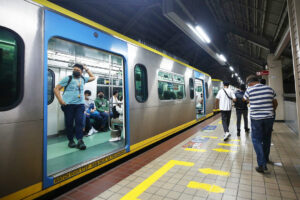THE Department of Transportation (DoTr) said Tuesday that the Palace has ordered a review of the inflation impact of two commuter rail fare hikes the department had approved in late March.
The Palace decision effectively pushes back the implementation date of the fare hike for Light Rail Transit (LRT) Lines 1 and 2.
The DoTr had approved the requested fare increase of P2.29 on boarding and an additional 21 cents distance for every kilometer traveled.
“This was approved by my office on March 27, and we reported this to the President. And the instruction of the President is to reassess the date of implementation for us to be able to determine the impact on inflation,” Transport Secretary Jaime J. Bautista said in a press conference on Tuesday.
Mr. Bautista said the instructions issued by President Ferdinand R. Marcos, Jr. also suspends the fare hike application process for Metro Rail Transit (MRT) Line 3, which had yet to be approved.
Mr. Bautista said the DoTr will discuss the impact of fare increases with the National Economic and Development Authority (NEDA).
“As far as the rate is concerned, it is already approved, but the implementation will be announced after we have conferred with NEDA and we will refer this back to the board of the LRTA (Light Rail Transit Authority),” said Mr. Bautista.
Once implemented, the minimum boarding fee at the LRT-1 and LRT-2 will be adjusted to P13.29 from P11, while the distance fee will be adjusted to P1.21 per kilometer from P1 per kilometer.
The DoTr said the new LRT-1 Single-Journey Ticket (SJT) fare scheme will be a minimum P15 and maximum P35. The previous range was P15-30. For Stored Value Cards (SVC), the minimum will rise to P14 from P12 and the maximum to P35 from P29.
Meanwhile, for LRT-2 the minimum SJT fare will remain at P15 while the maximum will rise to P35 from P30. The minimum SVC fare will rise to P14 from P12, and the maximum will rise to P33 from P28.
Mr. Bautista said that “the proceeds of the fare increase are intended to improve (the train operator’s) services, technical and technological capabilities to make mass transportation accessible, convenient and efficient for the riding public.”
Assistant Transport Secretary for Railways Jorjette B. Aquino said that the LRTA intends to allocate 97% of the expected incremental revenue for maintenance.
“It is the intention of the LRTA to allocate 97% or about P110 million of the expected P114 million additional rail revenue per year to augment funds for maintenance and other operating expenses,” Ms. Aquino said.
LRTA’s deficit for 2023 is projected at P8.5 billion, widening from P7 billion in 2022, according to Ms. Aquino.
“It has been actually operating at a loss and relying on government subsidies for its operations and maintenance,” she added.
LRT-1, LRT-2 and MRT-3 filed fare hike applications with the Rail Regulatory Unit (RRU) which held a hearing on Feb. 17.
Ms. Aquino said the MRT-3’s requested fare increase was not approved after it failed to meet the publication requirement as indicated by the RRU rules of procedure.
“LRTA and LRMC (Light Rail Manila Corp., operator of LRT 1 and 2) timely published their application and petition with notice of hearing in a newspaper of general circulation once a week for three consecutive weeks in accordance with the RRU rules of procedure,” she said.
She added that MRT-3, operated by Metro Rail Transit Corp., failed to publish its application 10 days before the hearing. — Justine Irish D. Tabile
